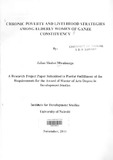| dc.description.abstract | This study is about chronic poverty and livelihood strategies among elderly women of Ganze constituency. It identifies the socio-economic characteristics of households containing chronically poor elderly women. It also investigated the livelihood activities undertaken by households containing chronically poor elderly women as well as the individual chronically poor elderly women themselves. The study also investigated the assets portfolio of the households containing chronically poor elderly women and also the economic factors affecting the livelihoods of the chronically poor elderly women. It also sought to understand some of the interventions that can be put in place to enhance the livelihoods of the chronically poor elderly women.
The study was guided by two conceptual frameworks: - the Sustainable Livelihoods Framework and the assets-mediating processes-activities framework. Data collection was done in two stages; the first being data collection through the participatory chronic poverty assessment seminars and the second stage of data collection being through the administration of structured questionnaires to individual chronically poor elderly women from chronically poor households. These households and individual chronically poor elderly women were identified by participants during the participatory chronic poverty assessment seminars based on local perceptions about the various attributes of chronic poverty. The study findings revealed that the chronically poor elderly women are not a homogeneous group and included the uneducated, the married, widowed, separated among others.
The study found out that the chronically poor elderly women undertake all kinds of livelihood activities coming their way so as to raise a livelihood though the most common livelihood activities were gardening in own farms and working in other people's farms as casual laborers. The study findings also revealed that the chronically poor elderly women adapt to a number of livelihood strategies such as skipping meals or going without food for a day, begging, keeping of children out of school or withdrawing them from school. Other livelihood strategies are: eating of edible wild vegetables and tubers, and putting their whole incomes in the purchase of food at the expense of other basic needs. On asset status, the study found out that households containing chronically poor elderly women have low assets status of both productive and household assets. the study found out that the most preferred intervention for the improvement of the livelihoods of the chronically poor elderly women is through food transfer, provision of shelter and cash transfers in that order. | en_US |

